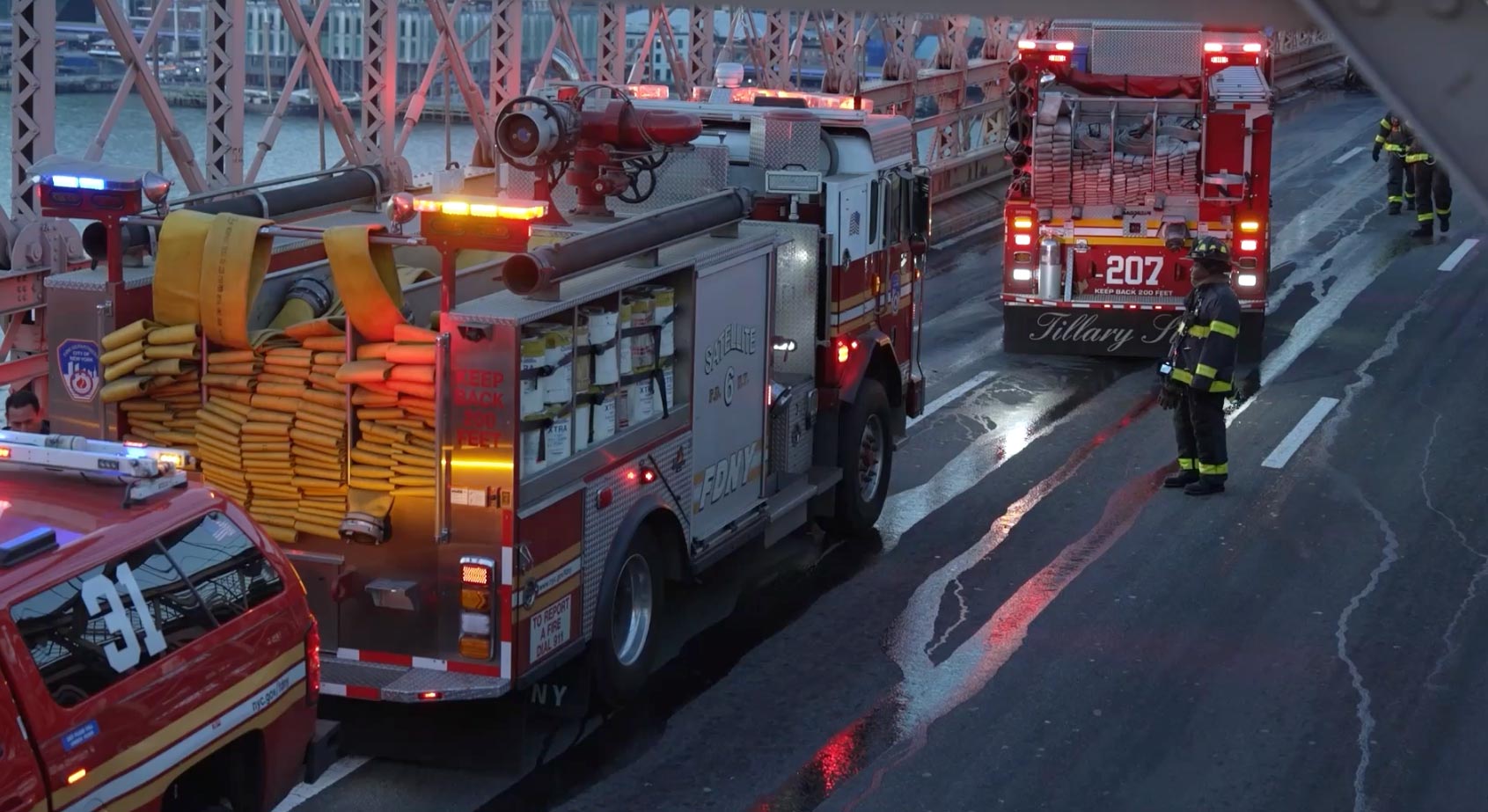
The Hidden Life of Empty Bottles
By Aljawhara Alhedfa
Tink, tank, clink, clank. People here and there with bags filled with bottles everywhere. That’s how Sure We Can, a redemption center that supports the local community socially and financially, welcomed me.
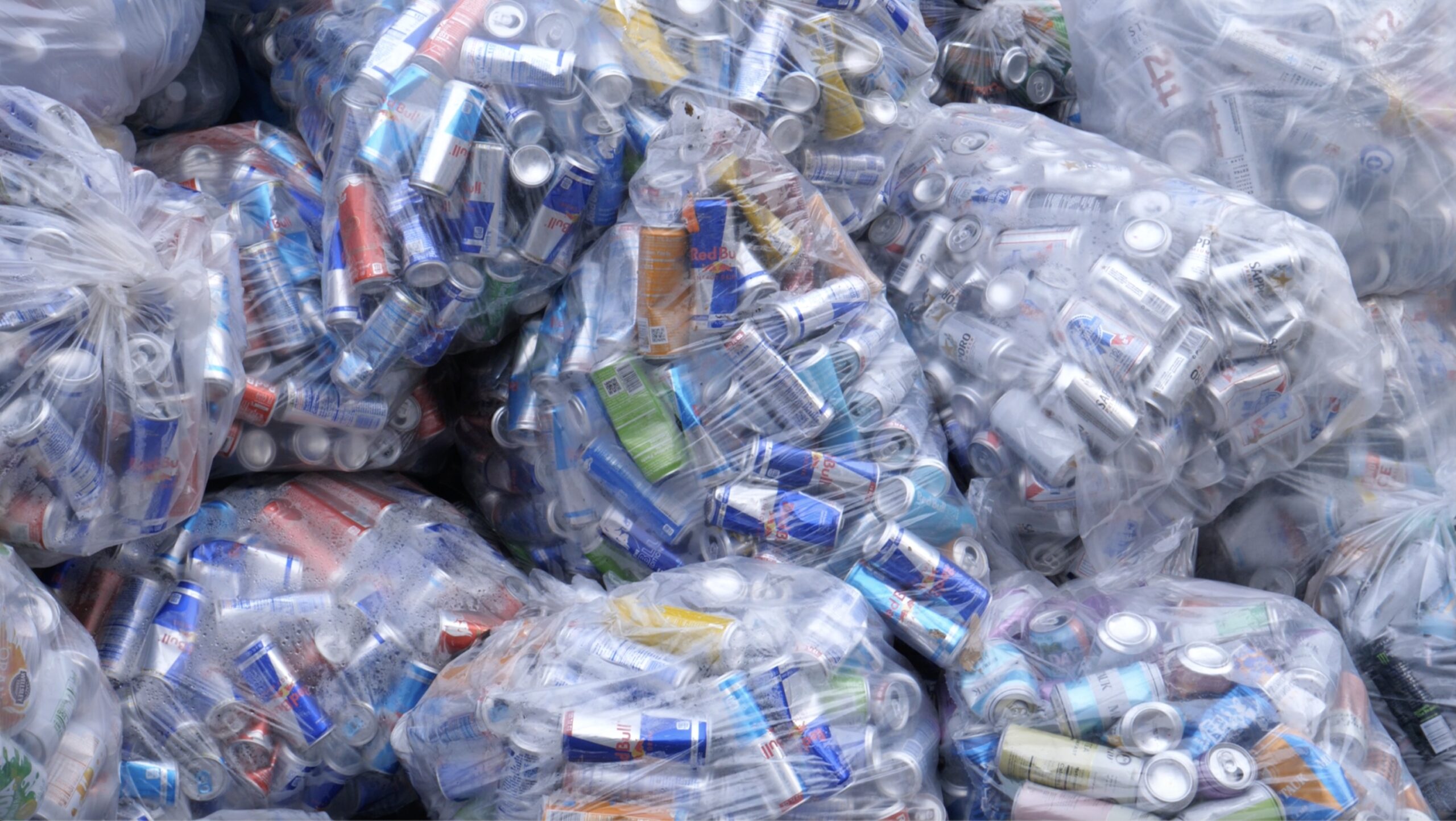
Cans in bags at Sure We Can. Photo by Aljawhara Alhedfa
Since 1982, the Returnable Container Act, also known as the “Bottle Bill” by New Yorkers, has been in effect to improve the recycling environment inside the city. Five cents can be redeemed from certain containers for each bottle or can that is disposed of correctly.
Seventy to 80 percent of recyclables have been returned ever since the bottle bill was introduced. One of the largest recycling factories is Balcones Recycling. Located in Brooklyn, it recycles glass, plastics, and metals.
The Department of Sanitation uses vehicles to collect recyclable objects from the curb after they have been placed there. When they are brought inside the truck, they are separated into three distinct categories: compost, recycling, and trash.
All recyclables are collected by DSNY, and then they are transported to either Balcones recycling (a private company that works with DSNY) or a factory that is located closer to the trucks. For the purpose of recycling, Balcones uses four distinct methods to sort the items: sizes and shapes, magnetic fields, optics, and hand.
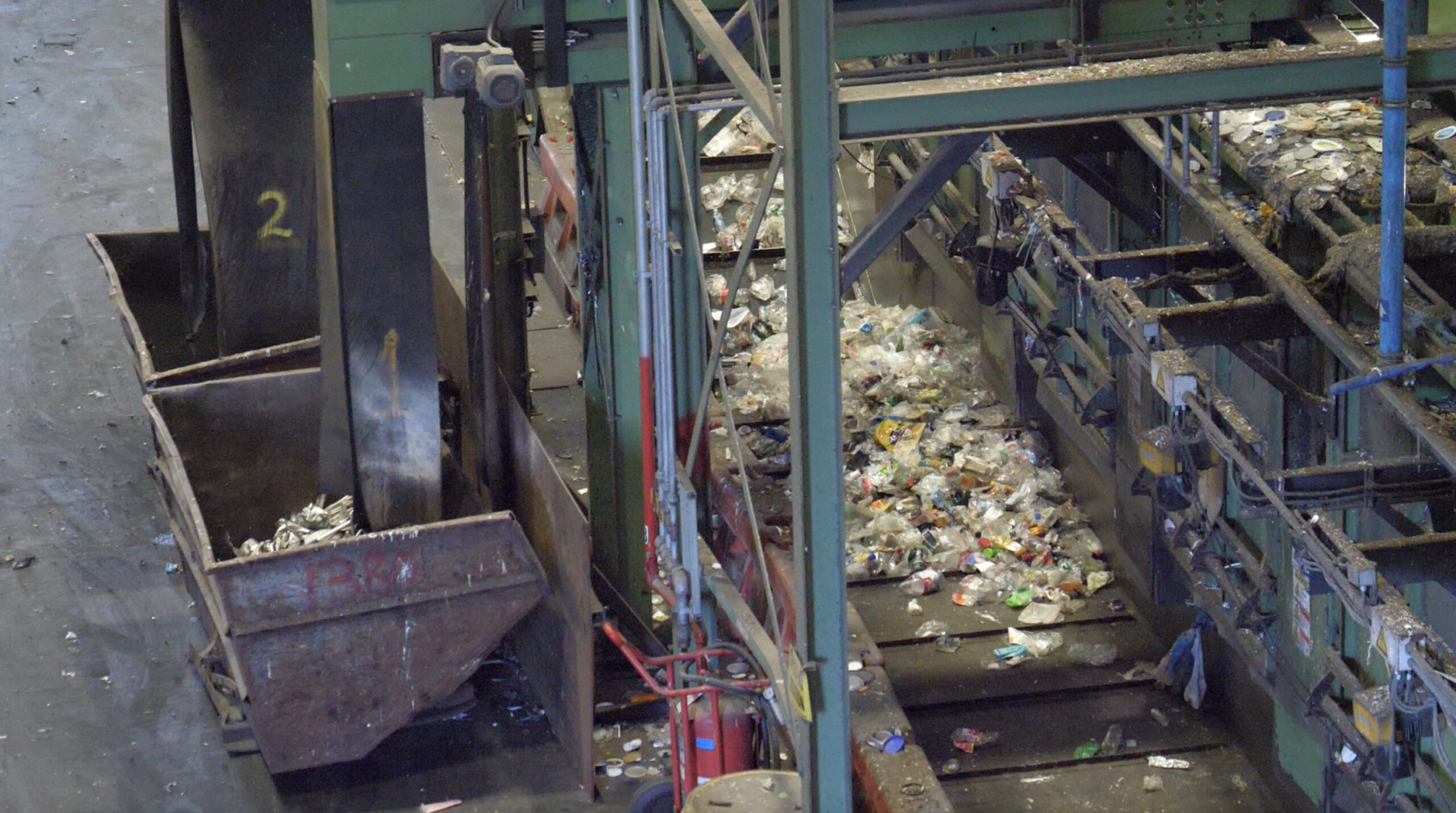
Balcones recycling factory. Photo by Aljawhara Alhedfa
Disc screens are used, and the spaces between them are 2.5 inches. Items that are smaller than 2.5 inches are able to pass through the gaps. Fragmented glass, bottle caps, minor metals, papers, and plastics are some of the items that can fall between the specs.
In the next step, metals are sorted using trommel screens, which are essentially enormous drums that attract magnets.
Objects that are two-dimensional are separated from three-dimensional objects, such as plastic bags and cans, by means of a ballistic separator.
Magnetic and non-magnetic metals are the two categories of metals that exist. Those recyclables that are magnetic are gathered together in one pile, while those that are not magnetic are separated out in another pile.
There are a wide variety of shapes and forms that plastics can take. Light in the near infrared spectrum is used in order to identify the molecular signature. The bottles that have a PET molecular signature are transported to a different conveyor belt by use of an air jet system.
Humans are responsible for the final step, which is the sorting of recyclables. This is done to ensure that there are no products to be found in places where they do not belong.
Products that can be recycled are transported to a baler, where they undergo compression before being distributed to re-processors and other manufacturers.
The technology used at Balcones represents just one facet of NYC’s innovative approach to recycling. The facility continuously updates its sorting technology to improve efficiency and accuracy.
Recent additions include artificial intelligence systems that can identify and sort materials at higher speeds than traditional methods. The facility processes an average of 800 to 1,000 tons of recyclable materials daily, contributing to the city’s goal of reducing landfill usage.
Kara Napolitano, the director of education and outreach at Balcones Recycling, insists on the importance of recycling. However, she added, “we don’t recycle to save the planet; we recycle to save materials.”
Napolitano said that the waste characterization report for the year 2023 indicates that 20 percent of the items in the blue bin are trash, while 70 percent are paper. Not only do they mail paper, but waste is a big cost for them.
Contamination remains one of the biggest challenges facing NYC’s recycling program. Beyond the 20 percent of trash found in blue bins, education efforts have become crucial for improving recycling practices.
People who collect cans and redeem them for cash back are called canners. They collect thousands of cans annually and some of these recyclables could have ended up in landfills if not for them.
“It really takes a village, like we’re working on this with the canners. We really need our whole community to support us especially for the political work,” said Ryan Castalia, the executive director of Sure We Can. “If these conditions are going to change it means laws have to change policies have to change elected officials and government agencies have to be held accountable to implement these things.”
Joshua Goodman is a deputy commissioner of DSNY and is responsible for public affairs. He thinks New Yorkers overthink recycling a great deal. “Put it in the recycling bin and let us figure out the contamination. We have processes, we have large pieces of equipment. We have long term contracts meant to deal with the contamination.”
Industrial recycling is one solution to the trash issue; however, organizations such as Sure We Can are working to address another essential aspect of the problem: providing assistance to the city’s most vulnerable recyclers, canners.
Some of the city’s working class and poor collect cans and utilize the “bottle bill” law to receive money to help them make a living.. Canners who work full-time often use the money they make from their business to pay their rent.
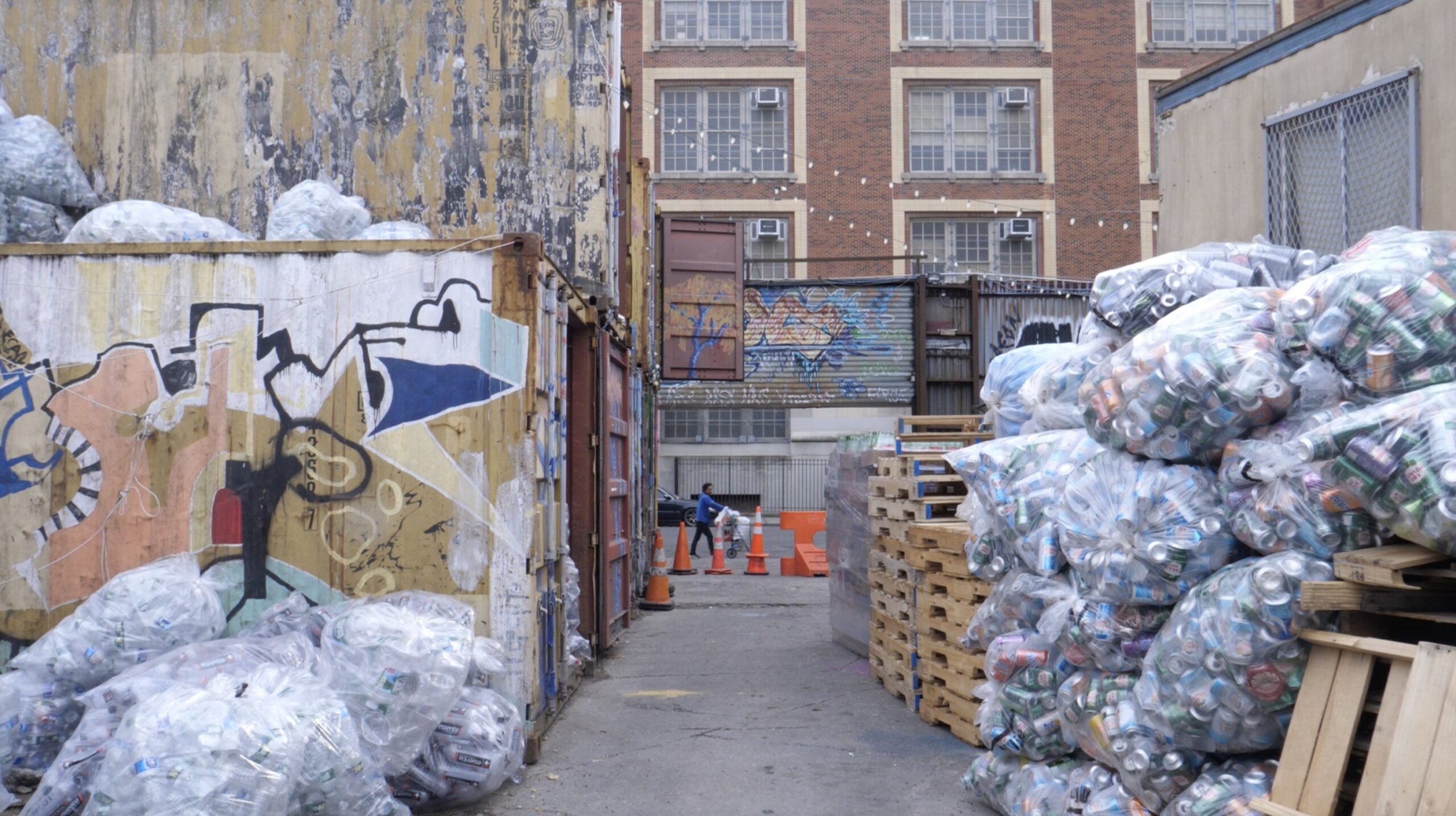
Sure we Can organization. Photo by Aljawhara Alhedfa
In addition to being an employee at Sure We Can, Pedro Romero is a regular canner. “Recycling is very important for those of us with low income, for example when someone loses their job and can’t find other options, other doors start closing, and they begin finding support through recycling,” he said.
The Department of Sanitation is implementing laws regarding the containerization of waste inside the city. The goal is to improve the quality of life while simultaneously reducing the number of rat sightings.
According to Goodman, containerization works and it reduced rats within the neighborhood by 60%. “Leaving the trash on the curb is just an all-night is an all you can eat buffet for the rats.”
Goodman argued that not only will the rat population decrease but neighborhoods will also end up looking better.
On the other hand, individuals such as Romero are now concerned about the possibility of a decrease in their income, particularly those who are wholly reliant on canning. “Sometimes the recycler isn’t afraid of that because it’s important to earn a cent to bring food home, to have something to buy things with.”
A little over 1,000 canners work within the Sure We Can community and around 8,000 canners operate within New York City, and according to their 2023 study, canners redeemed over 12 million containers in 2023.
Sure We Can operates as more than just a redemption center. The organization provides educational workshops, community gardens, and social support services to its members.
Castalia makes sure that his community is a safe space. “Here we try to flip that script and create a place where they can slow down interact with each other build community learn from each other like new owners can learn from more experienced careers cross-cultural engagement,” he said. “People who don’t speak the same language figuring out how to trade or share a joke.”
Re-Cycling
Unwanted Bicycles Get a Second Life
By Yitian Tang
On the Upper East Side of Manhattan, a basement door is open. Down a dimly-lit, yellow-colored hallway is a heavily-dusted silver TREK 700 hybrid bike with flat tires.
Lying next to the TREK 700 are a Giant, a Schwinn and an unidentified commuter bike, along with children’s bikes of different sizes–eight in total. They’ve been outgrown, replaced, discarded, abandoned or forgotten in a dark, musty, cobweb-ridden corner of this building until recently when the owner, a woman in her 60s, called to donate them.
A man slips on greasy, greenish protective gloves and carries out one bike at a time, crouching low to avoid hitting his head—he’s 6’2”, with long hair. He piles the bikes on the sidewalk, then walks two at a time toward a U-Haul mini truck after the donor closes the door.
His name is Rollin Walther, a mechanic and operator at Recycle–A–Bicycle, a nonprofit bike shop in Clinton Hill, Brooklyn. Having been a rider himself for a “long, long time,” he explains his work in a different way: “I am like a doctor, but instead of saving people, I save bikes.”
On a busy day, Walther would be driving a much larger truck around the city, picking up more than 60 abandoned bicycles. Yesterday, he collected 30 from a property manager who wanted to clean up the building; one day last week, he picked up 70 bikes from Columbia University. “We could have several trucks running around the city 24/7 and still not be able to collect all the abandoned bicycles,” Rollin said.

Statistics show that New York City has between 500,000 to 700,000 privately-owned bicycles, and 50,000 to 100,000 new bicycles are sold annually. Bicycles are an essential mode of transportation in the city. A ride to school. A route to the café . An escape from the world of concrete. Through the years, it becomes whatever its owner needs it to be. Then one day, its owner stops needing it, or it cost too much to repair it, or the owner wants something it cannot be. That’s the day the wheels roll to a final stop.
“That’s where we come in,” Walther explains while driving back to Brooklyn, “if people leave them on the street or throw them into a junkyard, that would be too late.” By “too late,” he means that those bicycles handled by Department of Sanitation often just end up in landfills, since figure of recycled trash in New York is only 17% percent. But in their hands, they can at least contact a recycling factory to collect the metal frames if the bike is beyond repair.
What Walther and Recycle–A–Bicycle do is divert abandoned bicycles from waste streams and landfills. They accept donations of unwanted bicycles, refurbish them, and resell them to people who need them for affordable prices–some even for free, like through the Earn-A-Bike program, which students can assemble their own bicycles and keep them.

The shop itself is simple: a green sign reads “Recycle–A–Bicycle,” and the space is filed with bikes and parts. On the wall, there is some news about this shop and a book with the title New York Bike Style. Four mechanics are busy working on bicycles. More than 50 ready-to-go bicycles sit on racks.
Greg Browning takes the Trek 700 from Walther, raises it slowly on an electric bike stand, and starts to disassemble it. He chose this one first because it features a 7-speed Shinamo CI–DECK, which shows the front and rear gears just like the speed and rev meter on a car. “I usually don’t like any car-imitating on bicycles, but I’m okay with this one,” he says with a grin.
Before becoming general manager of Recycle–A–Bicycle, Browning worked in bicycle industry for 14 years, starting in high school. “Compared to working in a traditional bike shop like Specialized, there are always new challenges here.”
Browning says they deal with all sorts of bicycles from every brand. Sometimes they need to prepare over 200 refurbished bikes for the mayor’s office to distribute. Other times, they train mechanics for New York’s Bike Path program to help its members get jobs maintaining Citi Bike.
As he talks, Browning strips down the Trek 700’s wheels and drivetrain, his hands moving quickly as he cleans them. He pulls off the old flat tires, places the wheels on a truing stand, and adjusts the spokes until the wheels are straight. He then installs a fresh set of Panaracer tires on the cleaned rims and puts them back to the frame.

After cleaning and reassembling the drivetrain, Browning fits new brake pads to the Trek 700, then labels it with a green “$350” tag, and places it on the rack for the next customer. The Trek 700 now looks just as good as new, and even more stylish with the yellow profile tires Browning chose for it.
Back in Sacramento, California, where Browning is from, there is a bike kitchen where people can pay a small fee and find parts that work for them. But things in here are more organized. Founded in the 1990s, this shop is self-sustainable, and now it has merged with Bike New York, a larger nonprofit cycling organization that hosts the Five Boro Bike Tour and runs many other educational programs.
After 6 p.m., Browning and some mechanics leave, and another man enters the shop. He begins moving bikes and setting up chairs. His name is Ben Goodman, the Operation and Education Manager. He’s just returned from teaching bike repair in a local high school, and tonight this shop will host a lesson on bike fitting.
Goodman has been working with the nonprofit bicycle world since he was 15. “The reason I am at a community bike shop, a mission-based organization is because I want to do more than just fix bikes, I consider myself an educator first, my favorite thing to teach happens to be bicycle repair.”
Goodman explains that their weekly bike lessons help people learn how to find the right bike and maintain it, so they’ll keep it longer, which leads to fewer bikes being abandoned or discarded.

As some customers walk in, one rider drops off a bag of bicycle parts and leaves with a receipt, which can be used for tax deduction for donating to a nonprofit organization. “When I get my new bike, I am going to donate my old one here,” says Patrick Cherry, who came in to inquire about bicycle donation. “There is just something very nice about the community aspect of this shop. I like the goal of this shop about recycle bicycles.”
Some even come by and drop expensive bikes like a European relic Colnago from the days when Tour de France riders smoked cigarettes in the saddle, or a full–carbon fiber Trek Emonda with electronic shifters. When the staff asks the donors why they are giving away such high–end bikes, they don’t say very much.
Recycle–A–Bicycle is the largest and most well-organized program of its kind in New York, but it is not alone. In New York, there is Mechanical Gardens Bike Co-op, and there are other nonprofit bicycle recycling projects across the US and the world like The Bike Works in Seattle, The Bike Project of Washington, D.C., and World Bicycle Relief, a global organization that aims to provide bicycles to communities in African countries to improve transportation.
Last year, Recycle–A–Bicycle diverted more than 2,000 bicycles from the waste stream, preventing a total of 45,000 pounds of waste from NYC’s landfills, and held lessons and events almost every week.
After a boom in the cycling industry, the bike shop business has cooled down a bit now. Unfortunately, some nearby bike shops have recently closed. But here, the bikes on the rack are constantly changing–customers keep coming and rate the shop highly.
When asked about their favorite memory, they explained that, because they work with local community organizations to build, refurbish, and distribute bikes, they don’t always see the immediate results of their work. However, in November 2021, they collaborated with Good Co Bike Club and the 77th Precinct to give away children’s bikes to several families. The most rewarding moment for them was seeing the joy on the kids’ faces when they learned they could take home their new bikes—fully refurbished by the Recycle-A-Bicycle team.
Eradicating E-Waste
The hidden cost of our tech obsession
By Lara Dihmis
We live in a world where technology has overrun us. We wear mini computers on our wrists, and carry them in our pockets. In North America alone, the average person owns around 13 devices. There are now more mobile phone devices than people in the world, and that’s just mobile phones.
Every year, tech companies churn out new devices that promise to be bigger, bolder and faster than their predecessors. Our old ones become obsolete.
When buying a new phone, it’s unlikely that the environmental implications are a first thought, if even a thought at all. But in reality, e-waste is the fastest growing part of this country’s waste stream — and in fact, it’s becoming the world’s biggest recycling issue.
Globally, e-waste generation is rising by 2.6 million tons annually, and is expected to rise to 82 million tons by 2030, according to United Nations statistics.
The electronic waste stream is the result of a deadly cycle of over-consumption, demand and increased production. But producing and purchasing a device is one thing; disposing of it is another.
Piles of old devices
In New York, there are systems in place to prevent improper e-waste disposal. “The city has by far the most robust e-waste responsible recycling program in the world,” according to John Shegerian, the founder of the country’s biggest e-waste recycling company ERI.
If you’re caught putting an old phone or laptop in your trash, you’ll be fined $100. To properly dispose of your old electronics, you would have to find a retail drop-off location or an e-waste collection event.
This might not be the most practical way of, say, disposing of a 32-inch flat screen TV, but without e-waste bins at every residential building, it’s the only viable option.
The New York Sanitation Department works with ERI to collect and process e-waste. The department organizes collection events across the city in coordination with ERI which picks up and transports the discarded electronics to their processing facility in New Jersey. From there, they’re sorted and sent to larger recycling plants in Massachusetts or Indianapolis.
Since its founding in 2002, ERI has recycled over one billion pounds of electronics across the country, and since 2012, over 357 million pounds in New York State.
But ultimately, it’s up to residents to properly dispose of their items, and in a city estimated to produce more than 400,000 tonnes of e-waste annually, there’s a long way to go.
In 2021, the Department of Sanitation reported collecting 2.2 tons of electronics per day, and recycling 24.4 tons a day. But in 2023 they reported a drop in daily collection and recycling, collecting a total of 1,520.7 tons and recycling 7,070.7 tons.
The improper disposal of old electronics poses significant environmental hazards. At an e-waste recycling drop off event in Central Harlem earlier this month, many residents dropping their old devices expressed environmental concerns as having driven them to participate in the event.
Among them was Alan Lewis, a project manager and Harlem resident of 20 years who brought a truckload of old electronics to the event. “It drives me nuts how difficult it is to dispose of these things,” he said. “I really just want to keep all this out of the environment.”
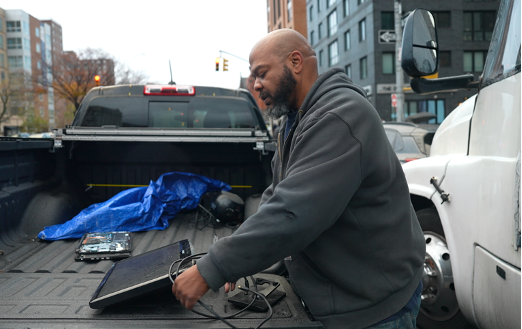
Harlem resident Alan Lewis brought a truckload of electronics to an e-waste drop off event in Central Harlem earlier this month.
These concerns also motivate volunteer groups, including the Lower East Ecology Center, to set up their own events and work with local recycling groups to make sure old tech is being repurposed where possible, or properly disposed of where not.
Old television screens are particularly toxic since they’re made of glass infused with lead, according to Oliver Clarke, a logistics officer for the Lower East Side Ecology Center.
“Phosphor powder is really toxic. If you just toss an old TV out in the street, it’s going to break and get into the atmosphere. So that’s what we’re trying to prevent here with these e-waste events,” he said.
Flat-panel TVs and monitors are also among some of the most toxic devices when disposed of incorrectly, since they use backlights containing mercury and phosphor powder to create vibrant images, which can be “highly hazardous if not handled correctly,” Clarke added.
A global problem
The two main goals of e-waste recycling are refurbishing devices for resale, or dismantling them to sell individual components. While valuable materials like gold, silver and copper can be extracted, the process is far from simple or universally applied.
In fact, e-waste is rising five times faster than documented recycling rates, despite advances in recycling, the UN this year reported.
In the United States alone, between 300 million and 400 million electronic items are discarded annually, but it’s estimated that less than 20% are recycled. Additionally, while e-waste constitutes only 2% of landfill waste by volume, it accounts for 70% of all toxic waste.
And the issue is by no means confined to the US. The growing global demand for electronics has led to an unequal burden on developing countries. According to the UN’s 2024 Digital Economy Report, those in developed nations not only own significantly more devices, but a considerable portion of their e-waste is exported to developing nations where formal recycling systems are often inadequate.
The disparity doesn’t end there. Developing countries often bear the brunt of environmental damage from mining the raw materials needed to produce electronics. Extracting these resources leads to pollution, deforestation and water scarcity, which further exacerbates the effects of climate change on these already vulnerable regions.
This is what drove Guillaume Charvon to found Walter Recycling, which since October 2021 has been operating out of Brownsville, Brooklyn, and collaborating with the Lower East Side Ecology Centre, among other clients including Louis Vuitton and John F Kennedy International Airport.
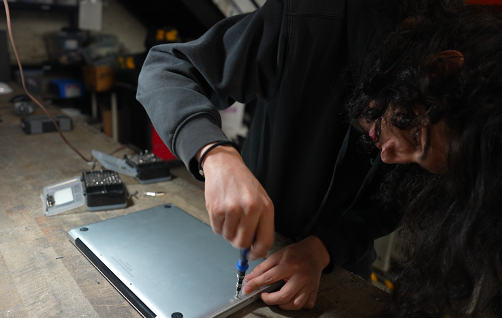
Tyler, an employee at WALTER Recycling, dismantles a laptop that can’t be repaired
Charvon’s work to address global waste inequities stems from his years living in West Africa, where he worked closely with local communities. He was largely inspired by Andre, a man in Burkina Faso who made a living collecting discarded plastic bags and transforming them into ropes to sell.
Despite the grueling nature of his work, Andre took pride in creating value from items others thought were no longer useful, which earnt him the nickname “The Great Repairman.” During his time there, Charvon also witnessed first-hand how the region’s role in supplying rare materials like lithium and palladium comes at a devastating cost.
“The mining of these resources generates conflicts, human rights violations and even child labor in places like the Democratic Republic of Congo. By addressing e-waste here [in New York], we’re also reducing the need for mining and the tragedies it causes elsewhere,” he said.
It’s difficult to grasp the correlation between our local consumption habits and their cross-continental impact, but in reality, overconsumption is directly linked to the often life-threatening conditions faced by those extracting resources and managing waste in developing countries.
“E-waste is still being shipped to countries like Ghana or India, where underserved communities rely on it for their livelihood. But the methods they use are damaging to their health and drastically shorten their life expectancy,” Charvon said, adding that developed countries need to take “ownership” of their waste instead of outsourcing the problem.
What can we do?
Most people find it difficult to part with old devices, whether for sentimental reasons or a lack of knowledge about proper disposal methods. While keeping an old phone in your drawer doesn’t necessarily cause harm, it reflects a broader disconnect between our consumer habits and their environmental implications.
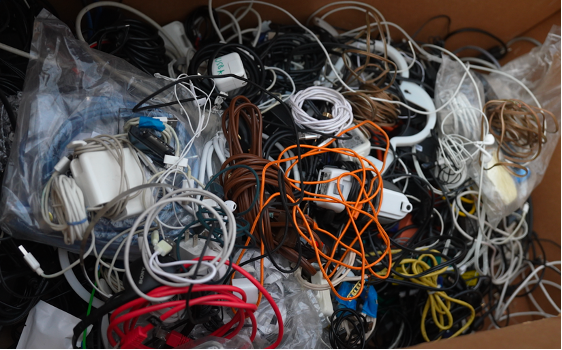
“E-waste is rising five times faster than documented recycling rates, according to a 2024 UN report.”
Ultimately, it’s up to us, as consumers, to break the cycle — starting with handing off old devices to entities that know how to properly handle and repurpose them. Equally important is recognizing that producing electronics is highly energy and resource-intensive, especially as the growing demand for them outpaces recycling efforts aimed at mitigating their impact.
Every device we own carries a story of resources extracted and energy consumed at every stage of its lifecycle. In a city like New York, where tech innovation and environmental urgency converge, managing e-waste isn’t just about proper disposal, but reconciling progress with sustainability.
For Lewis, this reconciliation demands a “cultural shift” in how we view and value our devices.
“Use your laptops and iPhones as much as you can — until you literally can’t anymore. Batteries can be replaced, apps can be deleted and RAM can be cleaned out to make it work,” he said, adding that we need to rethink our conception of “new.”
“I’ve given perfectly working laptops to people, and because it didn’t look the way they thought it should, they assumed it wouldn’t do what it was meant to do. By rethinking our idea of ‘new,’ we can start to shift the culture around consumption and disposal.”
Stop the fires
Why lithium-ion battery should be recycled?
By Gabriela Pinasco Nájera
Electric bikes and scooters have grown in popularity in New York over the last several years. Although they are an affordable mobility solution, the lithium batteries they contain can be explosive, and riders don’t know what to do with them once they’ve reached the end of their lifespan.
“When I first came to the Sanitation Department in 2021, we had three collection truck fires caused by lithium-ion batteries. This year alone, we’ve had 40,” said Vincent Gragnani, a press secretary for the Department of Sanitation.
These batteries tend to contain flammable materials such as nickel, cobalt, graphite, copper, and aluminum foils, as well as lithium, which, when compacted inside trucks with tons of garbage, can explode. And in New York, it’s illegal to dispose of rechargeable batteries as solid waste.
“People can be fined by the Department of Sanitation. Just like we fine people for not recycling metal, plastic, or paper, we can issue fines if they’re mixed with the trash,” said Gragnani.
One garbage truck driver for the Sanitation Department, Thomas, has twice had his vehicle catch on fire because of wrongly disposed lithium-ion batteries.
“You don’t want to get these batteries mixed with air or water, otherwise they could explode, and once they explode and the fire starts, you pretty much have to wait for it to burn out. It becomes dangerous for everybody,” he said.
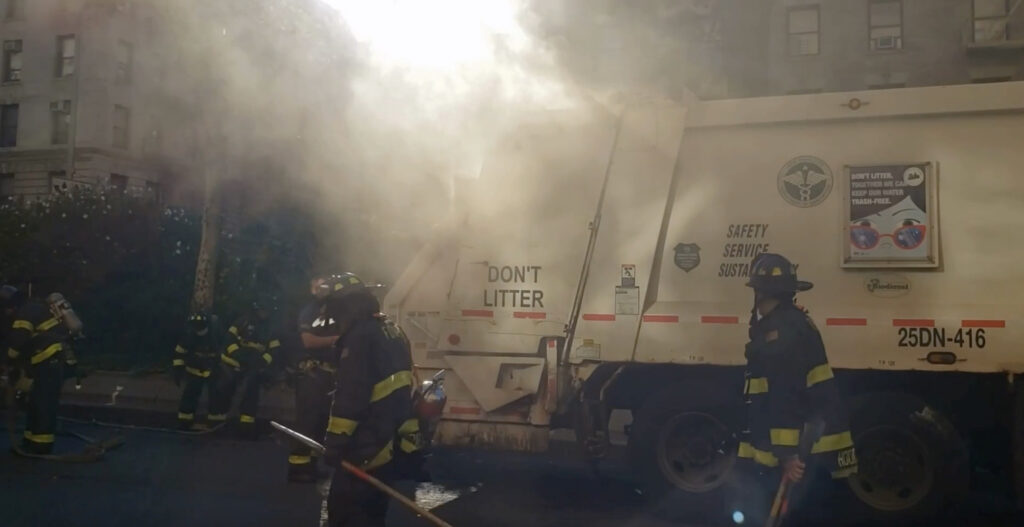
40 fires have been registered inside garbage trucks due to lithium-ion batteries in 2024. Photo: DSNY.
To understand just how dangerous these batteries are, they have caused over 220 fires, which have resulted in 88 injuries and 4 fatalities, in 2024 alone, according to the Fire Department. The most recent fire occurred in the early hours of December 3rd inside a bicycle shop. It took firefighters two hours to extinguish the dense flames caused by the chemicals inside these batteries. Last year, a battery fire destroyed an entire supermarket and a laundromat in the Bronx.
And the threat will only continue to grow as the demand for e-bikes rises. It’s estimated that by 2030, 12 million electric bicycles will be sold in the United States, according to the nonprofit group Call2Recycle. To tackle the issue, they have created the E-bike program, to educate consumers on how to properly recycle their batteries and where to drop them off safely.
“There are more and more e-bike batteries being placed on the market each year. Our E-Bike Program has collected about 2,100 batteries across the U.S.,” said Todd Ellis, the nonprofit’s vice president of services and solutions. “Those collections are mainly at independent bike dealers, and the program is voluntarily funded by e-bike manufacturers.”
The Call2Recycle website provides a map of e-bike stores that recycle lithium batteries. And beyond this initiative, New York State law requires all retail businesses that sell rechargeable batteries to accept them for recycling. However, while reporting, I found two stores out of ten that didn’t accept them, which is also illegal.
“This is a state law and it’s regulated by the State Department of Environmental Conservation. So if you go to a retailer that you believe should take a battery back and they won’t, you need to contact the State DEC about that. They’re the ones who would enforce it,” said Gragnani.
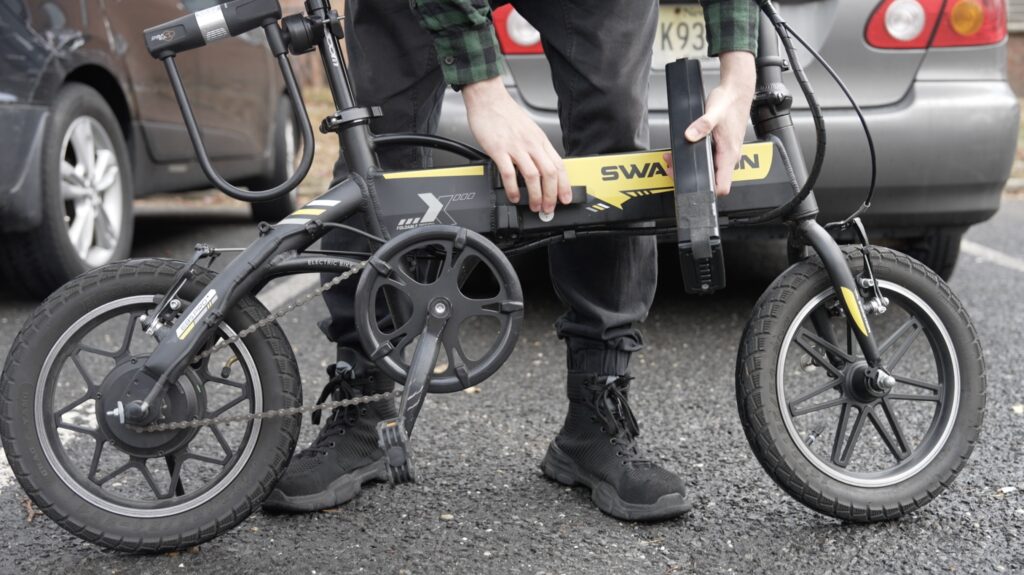
More than 12 million electric bicycles will be sold in the United States until 2023, according to NPO Call2recycle.
Delivery drivers and prevention campaigns
New York has five special waste drop-off sites that are open every Saturday and one Friday of the month in all five boroughs. These sites accept batteries or any other material that needs to be recycled and cannot be thrown in the trash.
But there’s a problem.
In New York City, the greatest users of e-bikes are food delivery drivers. Just walk through any neighborhood in Manhattan, and you’ll see them from morning to night, with their cell phones attached to the handlebars of their bikes, making one delivery after another. They sometimes work up to 15 hours at a time.
When I, a foreign student, tried to recycle my lithium batteries at one of the Sanitation Department centers, I was told I couldn’t because I didn’t have any type of U.S. ID like a driver’s license.
What about the many delivery workers who don’t have documentation? Of the 11 I spoke to, all were immigrants.
The Sanitation Department responded that only New York residents could use this service, though a utility bill or other non-governmental ID could be accepted.
Most of these delivery drivers have already had an average of two e-bikes, but none know how to recycle their batteries. They say they have never been informed about how to do it or where to take them.

A delivery driver holds the lithium-ion battery of his e-bike.
José Rodríguez is one of them. He speaks only Spanish and has never received information about the battery recycling process. What he does know is that they can be dangerous.
“You can only charge them with the proper charger, the one that comes with the battery, not with just any charger, otherwise they could explode. And only charge them for the right amount of time. When the charger shows green, that means it’s fully charged. Don’t charge them longer, or they’ll explode,” he said.
Remmington Belford, a press secretary for the Environmental Protection Agency, said that due to the increase in fires caused by these batteries, industry groups developed the “Avoid the Spark. Be Battery Safety Smart” campaign nationwide to inform consumers.
Meanwhile, the Department of Transportation’s “Check the Box” educational campaign aims to prevent serious incidents by raising awareness of everyday items that are considered hazardous materials in transportation. This includes batteries that are packaged and sent for recycling or disposal.
“Across the country, states, local governments, and solid waste districts are implementing campaigns to educate people about the hazards that lithium batteries can cause in the waste stream,” said Belford.
In New York, the Sanitation Department holds special events to educate the public on how to recycle these materials.
“We publicize these events, we send mail to every single New York City resident announcing them. And we operate them in every borough, usually in the spring and fall, and we accept those batteries as well,” Gragnani said.
Environmental risks and why recycling matters
Improperly disposed batteries can create fires which, according to the EPA, result in injuries, service disruptions, and monetary losses at waste management facilities. They can also cause water and air pollution. For example, when a lithium-ion battery is improperly discarded and catches fire, the water used to extinguish it can become contaminated with a variety of pollutants, and the gases released from the fire often include compounds that are harmful to human health.
Additionally, reusing and recycling lithium-ion batteries conserves natural resources by reducing the need for virgin materials and lowering the energy and pollution associated with extracting raw materials and manufacturing new products.
“Recycling is an activity that prevents the damaging effects of e-waste going to landfills. When chemicals from e-waste filter into the soil, they contaminate both water and soil. By recycling, we’re also preserving the planet’s resources,” Guillaume Charvon, CEO and founder of WALTER Working and Learning Together Environmental Recycling, said.
Lithium-ion batteries contain critical minerals that require energy to mine and manufacture. When we throw away batteries, we lose these valuable resources, resources that can never be recovered. Recycling also prevents batteries from being sent to facilities that are not equipped to safely handle them, where they could pose fire risks.
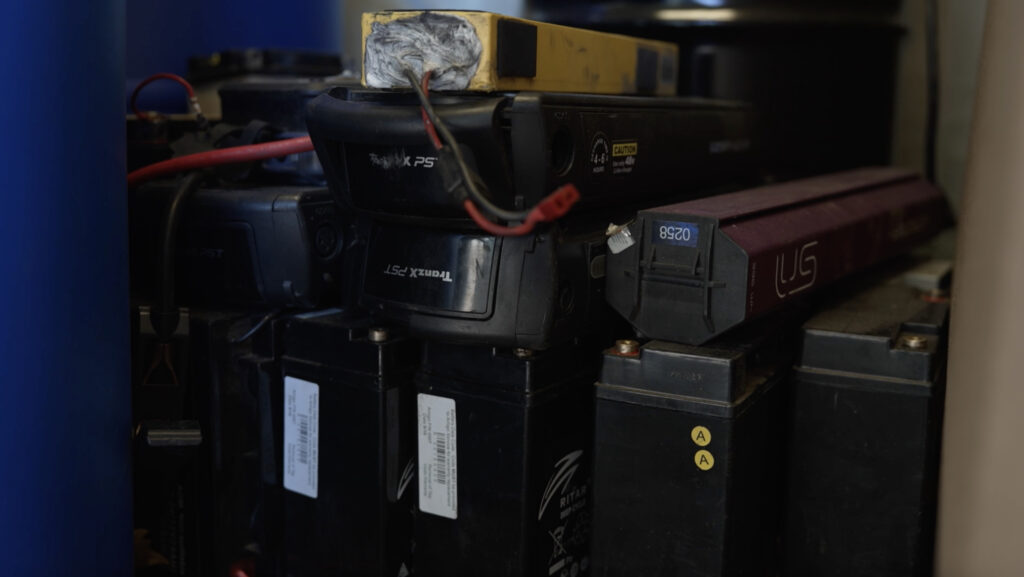
Li-ion batteries contain some materials such as cobalt, nickel, and lithium that are considered critical minerals.
Worldwide, only about 17% of these materials are recycled, Charvon said.
“Most of the mining for lithium and palladium occurs in countries where these sources generate tensions, which escalate into conflicts. There are no regulations, no oversight, and children work in these mines. This leads to human rights violations on many levels, just so companies can extract the raw materials needed for products like iPhones,” he added.
Building a domestic circular economy for batteries offers more than just environmental advantages; it has the potential to transform communities. By reducing the need for resource extraction, this shift could not only help protect the planet but also create job and economic opportunities in regions hosting recycling facilities.